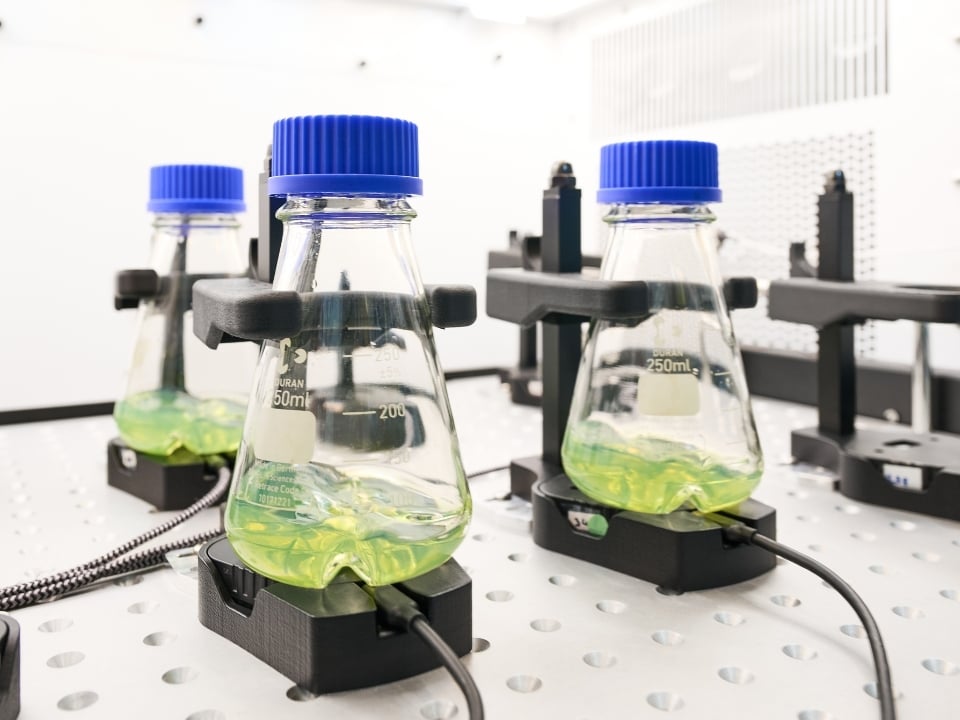Nanoparticles to the Rescue– A New Way to Monitor DO in Baffled Flasks

For decades, researchers have relied on baffled shake flasks to boost oxygen transfer. But there’s always been one missing piece: Reliable dissolved oxygen (DO) monitoring. Knowing the actual oxygen levels inside a culture could unlock better process optimization but baffled flasks posed unique challenges that made traditional DO sensors impractical.
Now, thanks to a brand-new nanoparticle-based technology, those limitations are finally being overcome. We sat down with Julius Muno, Product Strategy Manager here at sbi, to talk about the recent launch of our baffled shake flask solution—why it matters, how it was developed, and what it means for the future of microbial biotechnology.
1. What challenges led to the development of the nanoparticles for baffled flasks?
"Over the years, we have worked closely together with Professor Emeritus Jochen Büchs of the Aachen University, who is a renowned expert on bioprocessing in shake flasks and a big promoter of non-baffled shake flasks. He has taught us - and the wider shake flask community - that there are many advantages to avoiding baffles.
That said, anyone working with non-baffled flasks quickly realizes that with non-baffled shake flasks you can only get so much oxygen into your cultures. At some point many want to introduce baffled flasks to their process to optimize oxygen transfer. Our Dissolved Oxygen (DO) Sensor Pill is a very good solution for non-baffled flasks, but we saw that it didn't work for the baffled flasks to our and our customer's satisfaction. To address this, we set out to develop a different concept—one that would enable reliable oxygen measurements even in baffled conditions."
2. What were the biggest technical obstacles in creating a sensor solution that works reliably in baffled shake flasks?
"The form factor of the Pill imposed certain challenges with baffled flasks: The Pill collided with the baffles which led to abrasion of the coating and was unfavorable for both the shake flask and the sensor. That made us realize that we need to go away from a macroscopic DO Sensor, the Pill in this case, and go for something that is almost like in solution and does not collide with the baffles. That line of thinking led us to the concept of nanoparticles. They are not one large macroscopic DO Sensor but many tiny microscopic DO Sensors, and they don't collide with the baffles. As the nanoparticles are in solution, they're always in touch with the liquid, so we can guarantee that we're always measuring the actual oxygen concentration in the liquid phase and not in the headspace.
Another advantage is that the nanoparticles work regardless of the number of baffles or the specific flask design and even the material (glass vs. plastic). They are compatible with virtually any baffled flask. This had been the major challenge, and we believe we have found a very effective solution to overcome it."
3. Now that you've enabled DO monitoring in baffled shake flasks, what opportunities do you see for further innovation in small scale bioprocess monitoring?
"I would say baffled flasks were like the missing puzzle piece. When working with fast growing, aerobic organisms such as E. coli, oxygen supply is critical. Whether you are scaling up, developing processes, or running screenings under bioreactor-like conditions, it is essential to track dissolved oxygen (DO) to ensure cultures are not oxygen-limited. Oxygen limitations can trigger unwanted effects such as overflow metabolism, byproduct formation, pH shifts, and ultimately reduced product yields.
Baffled flasks provide a practical tool to increase oxygen transfer and avoid many of these limitations. While they cannot match the active stirring and gassing of benchtop bioreactors, they can reach oxygen transfer rates (OTRs) comparable to advanced microtiter plate systems or even some small-scale bioreactors. In fact, in many cases we have observed, baffled flasks can be sufficient for meaningful scale-up and even for processes designed with production in mind."
4. And have you seen any early success stories or pilot customer results that showcase the impact of this technology on process development or scale up?
"We have a very cool pilot customer at a local institute here in Germany who is optimizing his seed train. He works with an aerobic organism, Corynebacterium glutamicum, and wanted to ensure that even in his seed train and precultures the organism was not oxygen-limited. Otherwise, it could produce byproducts that lower the pH, which is undesirable. The goal was to have a culture in the right state when inoculating the bioreactor or moving to the next shake flask scale so that the culture can continue growing as fast as possible.
With DO monitoring now available for baffled shake flasks, he could finally investigate this. He also wanted to keep using his preferred flask, and by applying our nanoparticles, he was able to do so while still collecting important oxygen data. What he found was striking: Even with baffles, a low filling volume, and relatively high shaking speeds, he still experienced prolonged oxygen limitation. He had assumed there were no limitations, but the data revealed otherwise.
This insight allowed him to optimize his seed train by adjusting parameters such as filling volume and shaking speed (rpm), ultimately avoiding oxygen limitation. As a result, his cultures were in a better state both at the shake flask level and when transferred to the bioreactor — which is exactly what many people want to achieve and a result we are proud to help enable."
 |
About Julius Muno Julius was born in Mönchengladbach and is a biotechnologist by training. During his studies at the WWU Münster, he joined a project on plant biotechnology for his Bachelor thesis and focused on fungal and bacterial biotechnology during his Master of Science. After joining the regional Biotech Cluster BIO.NRW for a few months in 2016, Julius became the first sales representative of aquila biolabs which was still a young start-up. Given his insights in the field, he has recently been promoted to Product Strategy Manager of sbi and helps to find tailor-fit solutions for the problems biotechnologists are facing. Loving fermentation, Julius has a weakness for one of its oldest products: Beer (especially craft beer). Aside from that, Julius loves spending time with his two kids, the dog, friends and wider family. |
